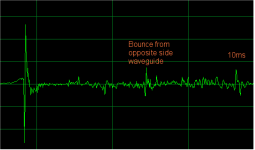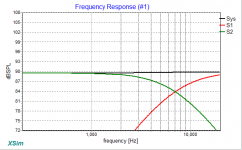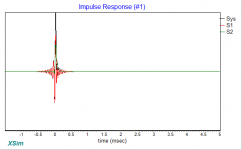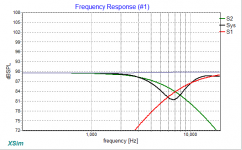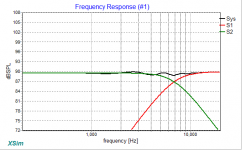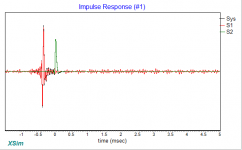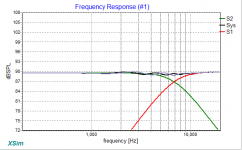Hi, Marco!
Both types of crossover will produce nulls off-axis, just in different locations. This is true regardless of the phase angles between the two drivers ... there's always a spatial location where the drivers are acoustically out of phase with each other.
The trick with a supertweeter is selecting a frequency where narrowband nulls, or more broadly, comb filtering have low audibility. In my experience, this is true for 7 kHz or higher. Nulls or comb filtering can result in unexpected elevation effects, thanks to mimicking pinna filtering, but there's not much effect on tone.
5 kHz? True, the vertical separation between drivers is several wavelengths, which is a no-no at lower frequencies, but I've found the biggest discontinuity is between drivers of different classes. If the overall tonality and dynamics are similar, integration is less difficult.
I still aim for a single impulse response at the listening position, though, even if it's a little funky off-axis. Dips in response, particularly for frequencies of 5 kHz and above, are much less audible than peaks, which have a way of standing out and drawing your attention to the crossover.
Thank you very much for your prompt reply!
Yes, I am aware that narrow off-axis nulls and comb filtering at such high frequencies are inevitable, regardless of the chosen crossover type. And I fully agree that if the crossover frequency is 7kHz or higher, then these are not directly audible. I also agree that using drivers of the same type/class favours a seamless integration.
In my experience, though, a difference remains between the "time aligned" APC and the "mis-aligned" CPC approaches:
(1) if adopting the "time-aligned" APC approach, when dead on the design axis there is no comb filtering and the response is flat, BUT when the relative phase tracking is lost (for small changes in the listening/measurement position), the two drivers end up operating in near phase opposition for almost a full octave, which results in a broad null that should, I think, be very audible.
(2) In the "mis-aligned" CPC approach, instead, at any angle within the listening window the same kind of comb filter is produced, with only narrow (sub-ERB) notches, and a consistently flat 1/3-oct smoothed response. (BUT, one gets the "double impulse" response due to the gross mis-alignment...)
Based on the above, I personally tend to lean towards option (2) as the least problematic of the two, but I am not 100% sure...
From your reply, I understand that you instead prefer the first approach (aiming for a single pulse), and I value your opinion... food for thought!
Thank you again, and feel free to elaborate some more if you wish!
Marco
Last edited:
I'm not sure I can remember the details of this speaker but I'll try because I was dealing with delay then as well.
It was a two way direct radiator and waveguide. I was crossing between 900 and 1200Hz. Vertical separation of between 40-50cm. Z axis separation of between 15-25cm.
I might have used some passive delay but was probably just incorporating it in the crossover. I don't use digital delay yet.
It was a two way direct radiator and waveguide. I was crossing between 900 and 1200Hz. Vertical separation of between 40-50cm. Z axis separation of between 15-25cm.
I might have used some passive delay but was probably just incorporating it in the crossover. I don't use digital delay yet.
Attachments
Lynn,
my initial impressions was that reflections from the horn top were more harmful to the overall sound than to have the AH425 further back.
I will try Scott suggestions latter, when a new support for the AH425 will be fabricated.
Also you are right about the effect of directivity control down to 135Hz.
The result in clarity in the power range was impressive, at least for me. Big difference from previous setup.
If you built this horn, let the drivers brake in for 100 hours first though.
As I told you I have a Beyma CP25 waiting, only no time at this moment.
Winter will be interesting!
my initial impressions was that reflections from the horn top were more harmful to the overall sound than to have the AH425 further back.
I will try Scott suggestions latter, when a new support for the AH425 will be fabricated.
Also you are right about the effect of directivity control down to 135Hz.
The result in clarity in the power range was impressive, at least for me. Big difference from previous setup.
If you built this horn, let the drivers brake in for 100 hours first though.
As I told you I have a Beyma CP25 waiting, only no time at this moment.
Winter will be interesting!
Thank you very much for your prompt reply!
Yes, I am aware that narrow off-axis nulls and comb filtering at such high frequencies are inevitable, regardless of the chosen crossover type. And I fully agree that if the crossover frequency is 7kHz or higher, then these are not directly audible. I also agree that using drivers of the same type/class favours a seamless integration.
In my experience, though, a difference remains between the "time aligned" APC and the "mis-aligned" CPC approaches:
(1) if adopting the "time-aligned" APC approach, when dead on the design axis there is no comb filtering and the response is flat, BUT when the relative phase tracking is lost (for small changes in the listening/measurement position), the two drivers end up operating in near phase opposition for almost a full octave, which results in a broad null that should, I think, be very audible.
(2) In the "mis-aligned" CPC approach, instead, at any angle within the listening window the same kind of comb filter is produced, with only narrow (sub-ERB) notches, and a consistently flat 1/3-oct smoothed response. (BUT, one gets the "double impulse" response due to the gross mis-alignment...)
Based on the above, I personally tend to lean towards option (2) as the least problematic of the two, but I am not 100% sure...
From your reply, I understand that you instead prefer the first approach (aiming for a single pulse), and I value your opinion... food for thought!
Thank you again, and feel free to elaborate some more if you wish!
Marco
To illustrate the above:
1) APC crossover @ 7kHz (2nd order L-R), with aligned acoustic centres:
http://www.diyaudio.com/forums/attachment.php?attachmentid=487574&stc=1&d=1433886759
and the corresponding impulse response on axis:
http://www.diyaudio.com/forums/attachment.php?attachmentid=487575&stc=1&d=1433886759
So far, so good.
But let's see what happens when slightly off-axis, so as to introduce 1 inch of mis-alignment:
http://www.diyaudio.com/forums/attachment.php?attachmentid=487576&stc=1&d=1433886759
Ugh!
2) CPC crossover @ 7kHz (2nd order Butterworth), intentionally grossly mis-aligned (5 inches):
http://www.diyaudio.com/forums/attachment.php?attachmentid=487577&stc=1&d=1433886759
(system response 1/3 octave smoothed to better approximate human hearing response, which is insensitive to narrow "comb filter" notches at high frequencies)
The corresponding impulse response shows the two peaks indicative of the mis-alignment:
http://www.diyaudio.com/forums/attachment.php?attachmentid=487578&stc=1&d=1433886759
But, let's see what happens when slightly off-axis, so as to introduce 1 additional inch of mis-alignment:
http://www.diyaudio.com/forums/attachment.php?attachmentid=487579&stc=1&d=1433886759
The response remains essentially unchanged.
Hence my doubt: is it better to optimize the frequency and impulse response on axis, and just live with the relatively major response aberration that is produced when even slightly off axis (1), or to accept a bad time alignment of the impulses, but at the same time ensure a more consistent (and essentially flat) frequency response both on- and off-axis (2)?
Marco
Attachments
- Status
- This old topic is closed. If you want to reopen this topic, contact a moderator using the "Report Post" button.
